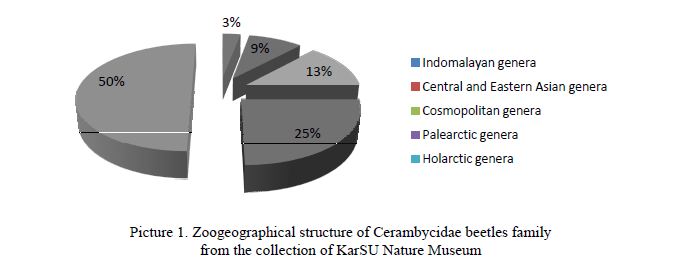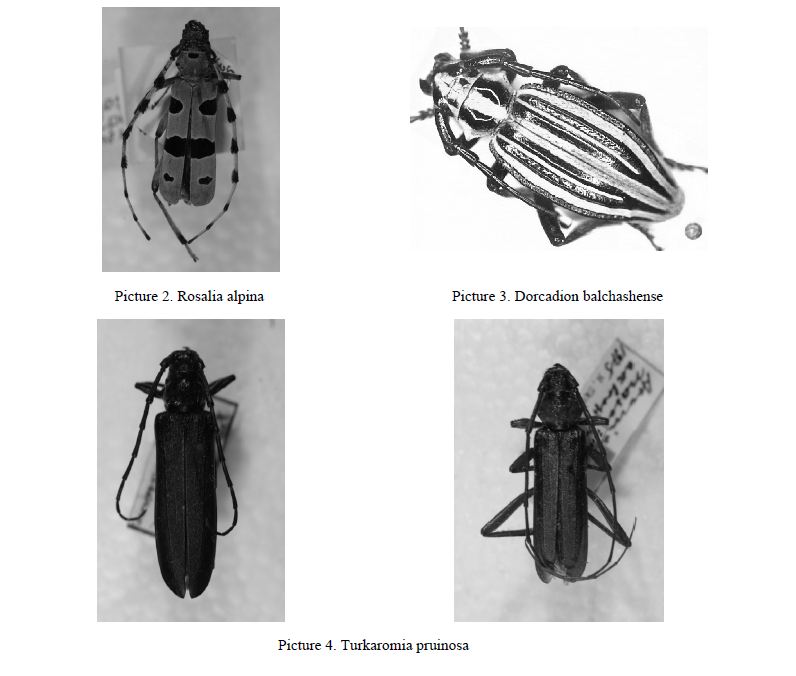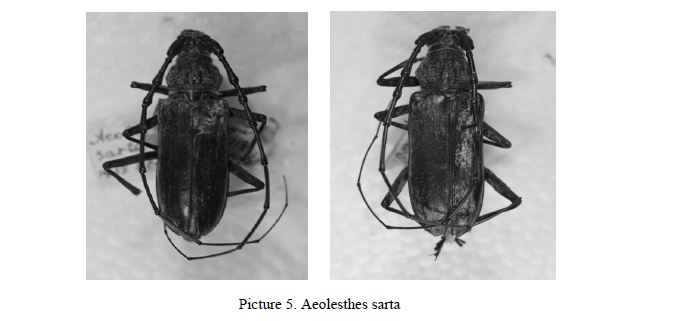The article presents the results of the zoogeographic of Cerambycidae beetles family structure studies on the of the entomological collection of the University Nature Museum. Zoogeographical analysis involves the genesis of the fauna individual elements assessing and union types which are similar in time and place of their origin in faunal complexes (belonging to a particular type of fauna). When you select a geographic complexes you should take into consideration not only the general character of the area and zonal-landscape attachment of species, but also known data about the centers of the origin. This analysis has shown that the Holarctic genera makes up the core of the Kazakh uplands fauna at the generic level, and unique species of the indo-malayan genera makes the smallest part of the collection.
The value of public collections (for example collections of national museums, research institutes or universities) increases due to the fact that they are the repositories of type specimens that are biological systematics act as carriers objective scientific name of a species or subspecies of living organisms and ensure their accessibility for further study. Museums now have scientific, historical, aesthetic value. They act as a carrier of unique and rare species and typical. The Zoological Museum conduct research on the taxonomy, faunistics, zoogeography, variation, comparative morphology and anatomy of animals, according to the theory of evolution, that is, the historical development of wildlife; educational work is carried out with schoolchildren and students, as well as a wide cultural and educational work in zoology, popularization and promotion of the idea of nature protection among the general population; consulted on zoological matters related to hunting, agriculture, forestry and medical zoology.
Cerambycidae spread almost all over the globe, where there is at least some forests in the north and even herbaceous vegetation in areas of warm and temperate climates. Their distribution is closely related to food plants, mainly with tree species. That is why most of their large number and variety of countries rich in woody vegetation, especially in the tropics [1].
Cerambycidae are involved in recycling dead wood as its primary destructors, therefore play an important role in the life of the plant communities, especially the forest. Harm caused by the larvae of Cerambycidae forest is often more significant than the damage caused by any other pest. Since they do not only physiological, but also the technical damage, that while thousands of acres of timber are suitable only bad firewood [2].
Materials and methods
The object of research is the collection of beetles of the family Cerambycidae, containing specimens collected in Eurasia from 1918 to 2013. We have analyzed morphologically 420 copies, 120 of which belong to the fauna and Kazakhstan belong to 35 genera and 66 species.
The main purpose of the study was to clarify the systematic position and classification of species of Cerambycidae represented in the collection of the Museum of Nature and the first compilation of the material composition of the collection and dissemination of Cerambycidae.
Identification, description and classification of specimens was carried out in the process of macroscopic shooting of beetle dried and labeled in duly carried out with a conventional camera Cannon. The study was conducted:
- clarify the diagnosis of all types of collections;
- macroscopic shooting of beetles;
- the study of ecology, morphology, biology of collection species;
- the statistical analysis of zoogeographical species of Cerambycidae collection from the collection of KarSU Nature
Results and discussion
the composition of the review and synthesis of the environmental, biocenotic and geographical features of the collection of the Museum of Nature barbel Kargu. After a particular distribution, origin and habitat of species of Cerambycidae of our collection, we learned zoogeographical characteristic representatives of the family Cerambycidae collection (Picture 1).

Picture 1. Zoogeographical structure of Cerambycidae beetles family from the collection of KarSU Nature Museum
Zoogeographical analysis is to reveal the main stages and ways of formation of regional fauna [3]. It involves an assessment of the genesis of the individual elements of fauna and species of similar association at the place and time of their origin in faunal complexes (assignment to a particular type of fauna). Each fauna has a certain systematic structure, in other words, specific distribution of species between genera, families and higher taxonomic units. The structure of the fauna is known not only in the proportion of different taxonomic units. Also a great importance may be geographical analysis of fauna, i.e establishing similarities and differences in the distribution of its constituent species. Species that are different in a similar spread, represent geographic elements fauna. When you select a geographic complexes are considered not only the general character of the area and landscape-zonal attachment of species, but what is known about the centers of origin. This approach often turns out that the species having similar current distribution, have different origins [4].
Thus, the geographical analysis of the fauna provides insight into the type of dissemination of its constituent species. But this is not enough knowledge of the fauna. It is necessary to find out the probable origin of the species, how they got into the fauna and as the origin of each of them affects the propagation. Answers to these questions gives a historical (or genetic) analysis of the fauna. It is based on a study of areas, not only species, but also genera. In carrying out its requires, first of all, to solve the problem, what elements of fauna emerged within the study area, and which were a result of the settlement of other centers. The first are called autochthonous elements, and the second — allochthonous (migration). The autochthonous flora composed mainly of species formed in the territory. They are formed in the centers of speciation, characterized by marked relief, long periods of isolation and the existence of relatively stable climate conditions (eg, mountain systems Karkaraly, Bayanaul, Kent, and others.). On the contrary, the vast plains (especially experienced in the recent past climate swings) fauna are almost always allochthonous [5].
This analysis showed that the core of the fauna of the Kazakh uplands at the generic level up Holarctic genera (50 %). In second place — the elements, which are widespread in the Palearctic (25 %). A large proportion of Holarctic and Palearctic elements is a large group species of Cerambycidae — the inhabitants of the forest cenoses. Conventional cosmopolitan species found in various landscape conditions around the world, make up 13 %. A small proportion of autochthonous associated with sagebrush-grass foothill communities and floodplain tugai forests. It is Central and Eastern Asian genera (9 %). The lowest part of the collection — 3 % — is represented by unique species of Indomalayan genera.
Thus, it was revealing, that the preference for many species of of Cerambycidae collection of plants growing singly and pioneer habitats determine their abundance in azonal landscape elements and a greater share in the composition of arctic and alpine fauna Holarctic. They are as follows:: Stenocorus, Evodinus, Gaurotes, Acmaeop, Leptura, Judolia, Strangalia, Arhopalus, Tetropium, Callidium, Xylotrechus, Rosalia, Saperda, Acanthocinus, Monochamus.
The uniqueness of the collection, among other things, makes it the only representative Holarctic relict genus Rosalia — Rosalia alpina (Picture 2).
This beetle has a length of 15–38 mm. Color — black, in a light gray or bluish hairy cover; antennae and legs usually bluish hairs pronotum with a black spot in the middle of the front edge; elytra with changeable black pattern that is usually represented marginal spot in the front third, in the middle of the wide sash and a small spot in the apical third [6]. Sides of pronotum with a blunt tooth. The third to sixth or thirdeighth antennal segments are at the top of the hair thick black brush. The antennae of the male is much longer than the body, the female shorter extend beyond the top of the elytra only the last two segments. Depressions front back open basins. Distribution: Europe, Middle East, Turkey, Lebanon, Georgia, Armenia, Azerbaijan, Kazakhstan possible (to be confirmed), Ukraine, Moldova, Belarus. In Russia, widespread in Voronezh, Rostov, Samara (Lada) and Chelyabinsk region., Krasnodar and Stavropol, Karachayevo-Cherkessia (Federal District), Kabardino-Balkaria, Chechnya, Ingushetia and Bashkortostan [7]. The number of prints in the collection — 1. A copy was brought from Ukraine in 1978.
It was also found the presence of two species in the collection of Cerambycidae, which are included in the Red Book of Kazakhstan. It — Dorcadіon balchashense (Picture 3), which belongs to the category III environmental significance — a rare species, and Turkaromia pruinosa (Picture 4), which refers to the importance of environmental protection сategory II — a decreasing species.

Picture 2. Rosalia alpina
Picture 3. Dorcadіon balchashense
Picture 4. Turkaromia pruinosa
Dorcadіon balchashense — the species, that belongs to the Palearctic genera. Beetle has a body length of 18 to 25 mm. Beetles are broad and massive. Antennae and lower leg is black, hip is brown. Elytra females have relatively developed scalp. In males, the scalp is only visible at the top elytron. Bands are darkish or cream. This is — a rare species with a small habitat. It occurs in the northern Balkhash. In Kazakhstan, found in the vicinity of Dolinka (Karaganda region), in the mountains Bektau-Ata (near Mountain Lake Balkhash). It inhabits the foothills of the valley and the foothills with sagebrush-grass habitats. The larvae develop in the grass, where they feed on the roots of herbaceous plants, mainly from the family of cereals. Beetles feed on green leaves of grass. The number is reduced due to the plowing of virgin lands and overgrazing in the habitats of species.
Turkaromia pruinosa — rare species with decreasing population. It belongs to the Palearctic genera. The area as a small, covered basins of Ili and Karatal. It inhabits riparian forests. Everywhere in Kazakhstan species has a low number with a sharp reduction in the tendency to local populations, the consequences of the negative impact of drainage of rivers, floodplains aridiizatsii, regulating the flow of rivers, as well as frequent fires in habitats.
Beetle has a length of 16 to 28 mm. Coloration of the upper body with a metallic luster, varies from green, bronze, purple to blue, rarely black, sometimes pronotum partly red. The main forage plant — willow. Flight of the beetle to the period from May to September.
The larvae develop under the bark at first, and then making their way deeper — into the wet wood and woody shrub willows, sometimes other trees. The larvae pupate in May and June. The life cycle of a single individual takes up to three years. Near the larvae in the wood musk barbel one host plant often develop Lamia textor.
Is a relict species, preserved in the north-eastern part of Dzungaria since the Tertiary period.
Another unique collection is a copy — Aeolesthes sarta (Picture 5). The age of this beetle is nearly 100 years old. Beetle was founded in 1917 in the town of Chardzhou (now Turkmenabat) in Turkmenistan and the museum received in exchange for Kazakh species. Availability of long-stored specimens is important for studying the dynamics of morphometric parameters of the family.

Picture 5. Aeolesthes sarta
This species belongs to the southern Palearctic genus. In Kazakhstan live 6 species. Special feature: long and narrow episterny metathorax, the length of which, at least four times the apparent width is relatively short first segment of hind legs. Simple, is not extended in a clove of antennal segments, 9th segment is shorter than the fourth.
This beetle has a length of Distribution: Afghanistan, India, 28–47 mm, dark gray-brown color, with silvery hairs on the elytra. Iran, China, Kyrgyzstan, Pakistan, Tajikistan, Turkmenistan and Uzbekistan. Developing all kinds of poplar growing in Central Asia, tree willows, elm species and many other hardwoods: Platania, walnut, apple wild plum, apple, apricot, plum, cherry, mulberry, locust, maple (rarely), birch, oak robur, hornbeam, alder and linden.
Beetles fly from late April to early May (in the beginning of the flight of the mountains later, at an altitude of 1000 meters above sea level from the first decade of June), in the south, in Turkmenistan earlier — in mid-April. First with an average daily temperature above 20 ºС. Flight lasts for most of June (lagging in the mountains or before terminating in the south). Males live a little longer than females. The beetles do not feed, and almost do not fly, are nocturnal, emerging at dusk and hide for a day in the larval tunnels, under peeling bark.
Thus it was made a great contribution to the improvement of classification and knowledge of the species composition, distribution and biological characteristics of members of the family Cerambycidae — specialized insect herbivores, which are of great ecological and economic value.
The greatest variety in our collection different subfamily Lepturinae, and habitat with the greatest variety of beetles — Karkaraly district elections and Bayanaul. This is due to the special climatic conditions (here the existence of large forest areas, providing a wide range of ecological niches for members of the family) these natural areas, are the most favorable for the spread of certain habitats and species in this subfamily.
For the first time gave an overview of the zonal differentiation of species collection of our museum that showed all its diversity, and by which, such a collection can be used in a variety of biological, ecological, geographical research.
References
- Kostin I.A. Beetles dendrophagous of Kazakhstan, Alma-Ata: Publisher of the Kazakh SSR Academy of Sciences, Institute of Zoology,
- Plavil'shchikov N.N. Fauna of the USSR. Insects Coleoptera. Vol. 21. Bugs lumberjacks, Pt. 1, Moscow, Leningrad: Publishing House of the Academy of Sciences of the USSR, 1936, 612
- Mamaev B.M., Danilevskiy M.L. Insects — timber and entomophagous, Moscow: Nauka, 1979, p. 80–97.
- Danilevskiy M.L. Morpho-ecological laws of evolution-longhorn beetle larvae: Authoref. dis. … cand. biol. sciences, 1967, p.
- Micheli C.J. Studies on the longhorned woodboring beetles (Coleoptera: Cerambycidae) of the West Indies: Mast. of Thesis Univ. of Maryland, 2006, 175 р.
- Zeh D.W., Zeh J.A., Bonilla M.M. Journal of Biogeography, Oxford, 2003, 30, p. 747–753.
- Zeh D.W., Zeh J.A., Tavakilian G. Biotropica, Oxford, 1992, 24(1), p. 86–96.